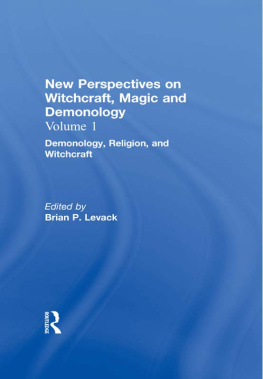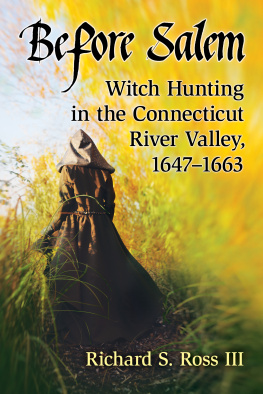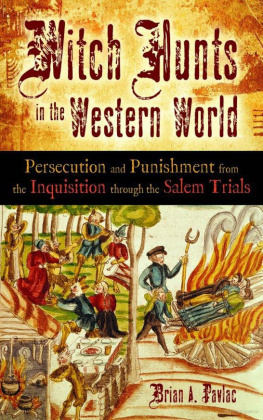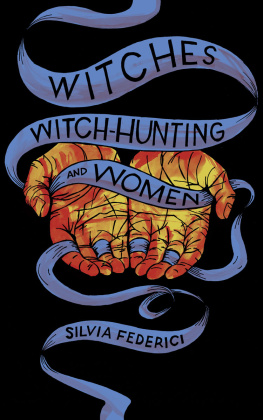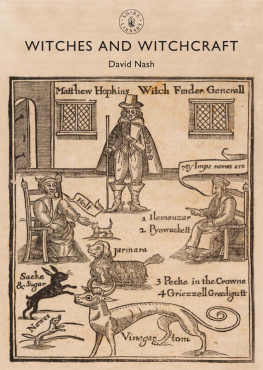Witch-hunting in Scotland
Between the late sixteenth and early eighteenth centuries Scottish courts prosecuted hundreds of women and men for the crime of witchcraft, an offence that involved the alleged practice of maleficent magic and the worship of the devil. Scottish witch-hunts claimed far more victims than the prosecutions that took place in the more heavily populated kingdom of England. Witch-hunting in Scotland presents a fresh perspective on the trial and execution of these people for inflicting harm on their neighbours and making pacts with the devil.
Brian P. Levack draws on law, politics and religion to explain the intensity of Scottish witch-hunting. Topics discussed include the distinctive features of the Scottish criminal justice system, the use of torture to extract confessions, the intersection of witch-hunting with local and national politics, the relationship between state-building and witch-hunting and the role of James VI. Scottish Calvinism and the determination of zealous Scottish clergy and magistrates to achieve a godly society are also examined as key factors.
This original survey combines broad interpretations of the rise and fall of Scottish witchcraft prosecutions with detailed case studies of specific witch-hunts. Throughout, extensive comparisons between Scottish witch-hunts and those that took place in England, New England and continental Europe are made. Witch-hunting in Scotland makes fascinating reading for anyone with an interest in witchcraft or in the political, legal and religious history of the early modern period.
Brian P. Levack is the John Green Regents Professor in History at the University of Texas at Austin. His publications on the history of witchcraft include The Witch-hunt in Early Modern Europe (third edition, 2006), The Witchcraft Sourcebook (2004) and Witchcraft and Magic in Europe: The Eighteenth and Nineteenth Centuries (1999).
Witch-hunting in Scotland
Law, politics and religion
Brian P. Levack
First published 2008
by Routledge
711 Third Avenue, New York, NY 10017
Simultaneously published in the UK
by Routledge
2 Park Square, Milton Park, Abingdon, Oxon OX14 4RN
Routledge is an imprint of the Taylor & Francis Group, an informa business
2008 Brian P. Levack
Typeset in Garamond by
HWA Text and Data Management, Tunbridge Wells
All rights reserved. No part of this book may be reprinted or reproduced or utilised in any form or by any electronic, mechanical, or other means, now known or hereafter invented, including photocopying and recording, or in any information storage or retrieval system, without permission in writing from the publishers.
British Library Cataloguing in Publication Data
A catalogue record for this book is available from the British Library
Library of Congress Cataloging-in-Publication Data
Levack, Brian, P.
Witch-hunting in Scotland: law, politics, and religion / Brian P. Levack
p. cm.
Includes bibliographical references and index.
1. Witchcraft-Scotland. 2. Witchcraft-Great Britain. I. Title.
BF1581.L38 2007
133.4'309411dc22
2007013926
ISBN13: 9780415399425 (hbk)
ISBN13: 9780415399432 (pbk)
To Chris and Andy
This book has two main purposes. The first is to offer an interpretation of Scottish witch-hunting that emphasizes the influence of law, politics, and religion on Scottish witchcraft trials. The second is to explain why witch-hunting in Scotland was much more intense than in England. shows how the patterns of witch-hunting in Scotland and England began to resemble each other during the revolutionary years of the mid seventeenth century, when Scottish covenanters and English puritans both acquired political power. The remaining chapters deal mainly with Scottish witch-hunting but make frequent references to England as well as continental Europe.
Most of the chapters in this book originated as articles essays, papers, or lectures I have presented over the past twenty-five years. Because these items once stood by themselves, they sometimes repeat points made earlier in the text. In blending the chapters together I have eliminated some but not all of the repetition. I have tried to make it possible for individual chapters to be read by themselves with only minimal reference to what has gone before.
In quoting original sources I have modernized spelling and punctuation, except in the titles of books. I have made this decision reluctantly, since it has meant eliminating the distinctly Scottish spelling of English words. In the end, however, I chose to modernize these passages in the interests of readability. I have, however, maintained all Scottish words, giving their English equivalents in parentheses when necessary.
Preliminary versions of most of the chapters of this book were presented as lectures or papers at universities and libraries in many different locations. These include the University of Edinburgh, the University of Glasgow, the University of Exeter, the University of Texas at Austin, Fordham University, Washington and Lee University, Northwestern University, the Huntington Library, the Folger Shakespeare Library, the Essex Institute, the University of Melbourne, the University of Adelaide, the University of Queensland, the University of Hobart, the University of Oslo, and the University of Tampere. I have also read papers on the subject at meetings of the North American Conference on British Studies, the Sixteenth Century Studies Conference, the American Historical Association, and the American Society for Legal History. I wish to thank the scholars and students who attended these presentations for helping me refine my arguments and identify new sources.
Large portions of regarding the possession of Anne Gunter first appeared in my article, 'Possession, witchcraft and the law in Jacobean England', Washington and Lee Law Review 52 (1996).
Because my work on this topic has spanned so many years, the debts I have incurred from scholars reach back just as far. During the early years of my research I benefited greatly from conversations with the late Christina Larner, whose premature death dealt a terrible blow to witchcraft scholarship. My debt to Richard Kieckhefer, who helped me teach my first seminar on witchcraft at the University of Texas, goes back even further. Richard and I have continued to share our ideas on witchcraft for more than thirty years. More recently I have benefited from conversations and correspondence with Julian Goodare, who shares with me a deep interest in Scottish witch-hunting. The work that he and his colleagues Lauren Martin, Joyce Miller, and Louise Yeoman did in producing the Survey of Scottish Witchcraft greatly facilitated the last few years of my research. Scholars and colleagues who have helped me in various ways include Ted Cowan, John Cairns, Hector MacQueen, David Sellar, John Langbein, Stuart Macdonald, Michael Wasser, Jenny Wormald, Stuart Clark, Malcolm Gaskill, Jim Sharpe, Cynthia Herrup, Erik Midelfort, Bill Monter, Owen Davies, Charles Zika, Sarah Ferber, Wilfrid Prest, Richard Golden, Johannes Dillinger, Alfred Soman, Rune Hagen, John Young, and Paula Hughes.
No one has spent as much time reading my drafts and listening to my ideas on witchcraft than my wife of forty years, Nancy Levack. An author and editor in her own right, she read an early draft of this manuscript and gave me much valuable advice for improving it. Our two adult sons, Chris and Andy, have not been so closely involved in the production of this book, but they have shared with Nancy and me many of the high and low points of my research on the subject. They have also acquired from me a love of Scotland and single malt whisky. As I complete this manuscript in the beautiful hill country of Texas, I thank them for their love and support, raise my glass, and dedicate this volume to them.



